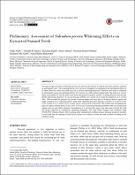Options
Preliminary assessment of Salvadora persica whitening effects on extracted stained teeth
Journal
Journal of Applied Pharmaceutical Science
Date Issued
2017
Author(s)
Nadia Halib
Nabilah Bt Nuairy
Haslinda Ramli
Ishak Ahmad
Norinsan Kamil Othman
Salihatun Md Salleh
Saiful Bahari Bakarudin
DOI
10.7324/JAPS.2017.71217
Abstract
The roots, twigs and stems of Salvadora persica (S. persica) also known as miswak have been used for centuries as oral hygiene tools. The cleansing efficacy of S. persica is thought to be attributed to the mechanical effects of its fibres. However, there is no study focus on S. persica whitening behaviour. Therefore, this study is conducted to preliminarily assess the whitening effects of S. persica on coffee and tea stained teeth. The bark of S. persica stems were peeled off and the pulps were dried and ground to produce powder. Scanning Electron Microscopy (SEM) and Energy dispersive X-ray spectroscopy (EDX) were carried out to study the properties of S. persica fibre. SEM revealed the presence of crystals of various shapes and sizes that act as natural abrasive agents and might contribute to its whitening effects while EDX identified that these minerals constitute of O (43.44 wt%), C (31.2 wt%), S (11.7 wt%), Ca (11.2 wt%), Na (1.3 wt%) and K (1.04 wt%). The powder later formulated into paste of various concentrations; 0.3%, 0.4%, 0.5% (w/w). Extracted permanent premolar teeth were cleaned and stained with tea and coffee solutions. Formulations of S. persica fiber paste were then used to brush the teeth and being compared to commercial whitening toothpaste. The teeth shade changes were evaluated using VITAPAN� Classical Shade. After brushing under standardized condition using a brushing simulator machine, it was found that the staining of teeth buccal surface was reduced at least one tone of shade according to the VitaPan� shade. � 2017 Nadia Halib et al.
File(s)
Loading...
Name
Preliminary assessment of Salvadora persica whitening effects on extracted stained teeth.pdf
Size
703.81 KB
Format
Adobe PDF
Checksum
(MD5):b8248062186b79f513dd21d1de629970